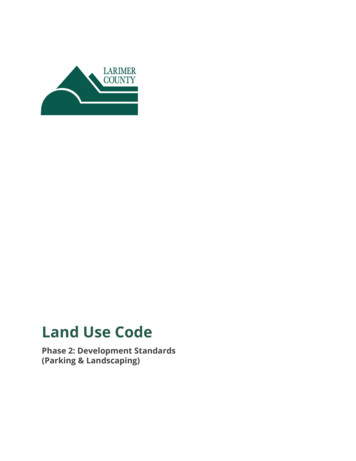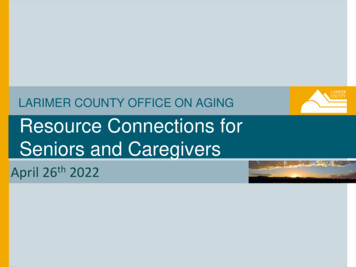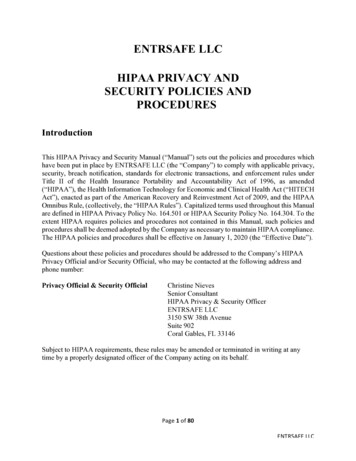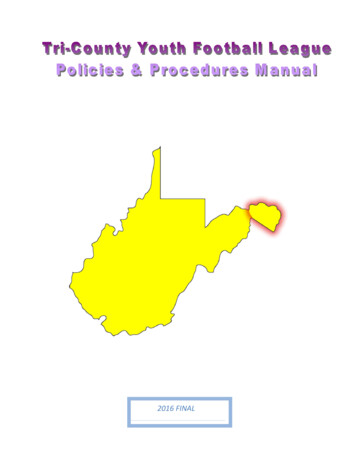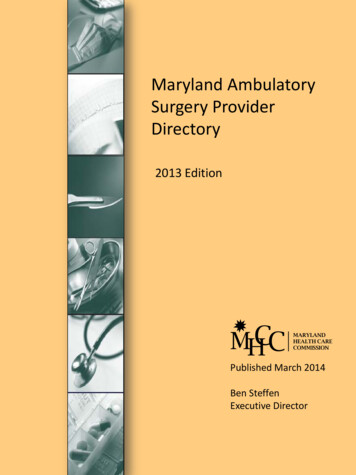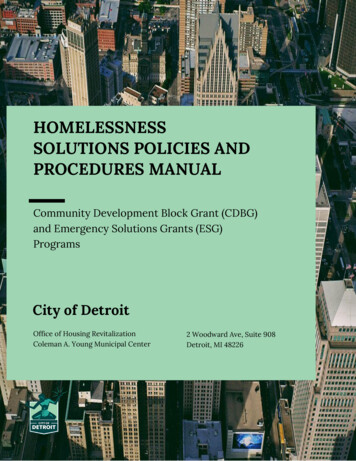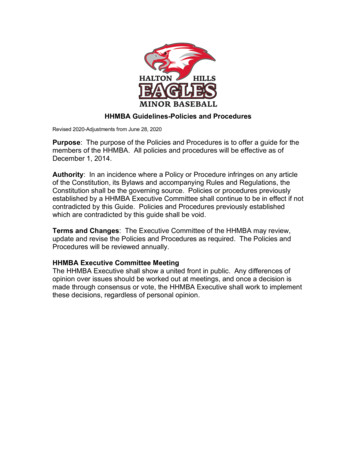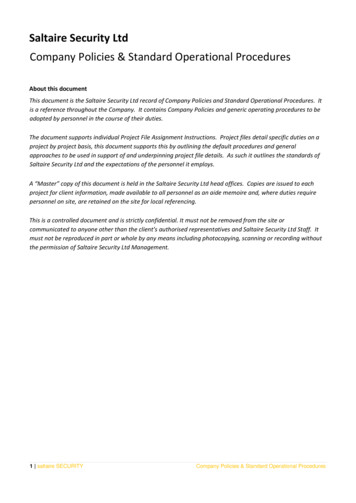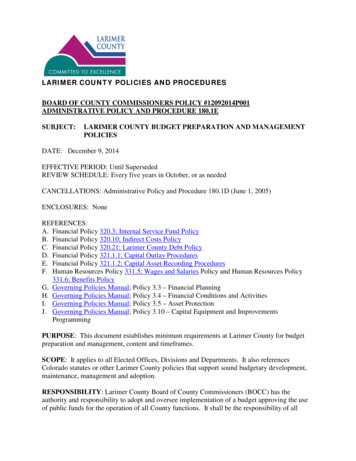
Transcription
LARIMER COUNTY POLICIES AND PROCEDURESBOARD OF COUNTY COMMISSIONERS POLICY #12092014P001ADMINISTRATIVE POLICY AND PROCEDURE 180.1ESUBJECT:LARIMER COUNTY BUDGET PREPARATION AND MANAGEMENTPOLICIESDATE: December 9, 2014EFFECTIVE PERIOD: Until SupersededREVIEW SCHEDULE: Every five years in October, or as neededCANCELLATIONS: Administrative Policy and Procedure 180.1D (June 1, 2005)ENCLOSURES: NoneREFERENCES:A. Financial Policy 320.3; Internal Service Fund PolicyB. Financial Policy 320.10; Indirect Costs PolicyC. Financial Policy 320.21; Larimer County Debt PolicyD. Financial Policy 321.1.1; Capital Outlay ProceduresE. Financial Policy 321.1.2; Capital Asset Recording ProceduresF. Human Resources Policy 331.5; Wages and Salaries Policy and Human Resources Policy331.6; Benefits PolicyG. Governing Policies Manual; Policy 3.3 – Financial PlanningH. Governing Policies Manual; Policy 3.4 – Financial Conditions and ActivitiesI. Governing Policies Manual; Policy 3.5 – Asset ProtectionJ. Governing Policies Manual; Policy 3.10 – Capital Equipment and ImprovementsProgrammingPURPOSE: This document establishes minimum requirements at Larimer County for budgetpreparation and management, content and timeframes.SCOPE: It applies to all Elected Offices, Divisions and Departments. It also referencesColorado statutes or other Larimer County policies that support sound budgetary development,maintenance, management and adoption.RESPONSIBILITY: Larimer County Board of County Commissioners (BOCC) has theauthority and responsibility to adopt and oversee implementation of a budget approving the useof public funds for the operation of all County functions. It shall be the responsibility of all
180.1E pg. 2Elected Officials, Division, and Department Heads to ensure compliance with provisions of thisPolicy and Procedure.SPECIFIC REQUIREMENTS: See Section II (State Mandated Budget Requirements) andSection IV,4.1.9 (Budget Timelines).REVISION LOCATOR:1. Section I, 1.17 (subsections added)2. Section IV, 4.6.33. Section IV, 4.7 (added)POLICY AND PROCEDURE:I. DEFINITIONS:1.1. “Adopted Budget” means the budget as adopted and amended by the Larimer CountyBoard of County Commissioners (BOCC) for a spending agency for a fiscal year.1.2. "Appropriation" means the authorization by ordinance or resolution of a spendinglimit for expenditures and obligations for specific purposes.1.3. “Balanced budget” is a budget in which anticipated revenues plus “unreserved” and“undesignated” fund balance usage is equal to or greater than anticipated expenditures.1.4. "Budget" means the complete estimated financial plan of Larimer County for a fiscalyear.1.5. "Budget year" means the ensuing fiscal year. Larimer County’s fiscal year runs fromJanuary first to December thirty-first.1.6. “Capital Project” A capital project is defined as land and land improvements,buildings & building improvements, and infrastructure (roads, bridges, etc.) whichbenefits more than a single fiscal period and meets the dollar threshold specified in theCapital Asset Policy (reference E).1.7. "Certified" means a written statement by a member of the governing body or a personappointed by the governing body that the document being filed is a true and accuratecopy of the action taken by the governing body.1.8. “Code combination” means the coding system used by the financial managementsystem and budget systems to classify financial transactions.1.9. “Colorado Local Government Law” means Title 29, Article 1, Part 1, of theColorado Revised Statutes defining the requirements for: budget format and content,hearings and adoption, appropriation resolution, filing the budget and amending thebudget during the year.1.10. “Designated Fund Balance” is that portion of the fund balance designated fortentative future plans.1.11. “Emergency” is an event requiring unbudgeted expenditures caused by an act of God,or the public enemy, or some contingency that could not have been reasonably foreseenat the time of adoption of the budget. "Emergency" excludes economic conditions,revenue shortfalls, or district salary or fringe benefit increases.1.12. "Expenditure" means any use of financial resources consistent with its basis ofaccounting for budget purposes, for the provision or acquisition of goods and servicesfor operations, debt service, capital outlay, transfers, or other financial uses.
180.1E pg. 31.13. "Fiscal year" means the 12 month period of January 1 through December 31 to whichthe annual budget applies and at the end of which Larimer County determines itsfinancial position.1.14. "Fiscal year spending" means all expenditures and reserve increases except, as to both,those for refunds made in the current or next fiscal year or those from gifts, federalfunds, collections for another government, pension contributions by employees andpension fund earnings, reserve transfers or expenditures, damage awards, or propertysales. This definition is used in TABOR compliance calculations.1.15. “Full accrual accounting” is based on revenues being recorded in the period whenthey are earned. Expenses are recorded in the period when the goods or services areconsumed. The multi-year benefits of some assets are recognized by being expensedover the time they are expected to be used, as opposed to only at the time of theiracquisition.1.16. "Fund" means a fiscal and accounting entity with a self-balancing set of accounts inwhich cash and other financial resources, all related liabilities and residual equities orbalances, and changes therein are recorded and segregated to carry on specific activitiesor to attain certain objectives in accordance with special regulations, restrictions, orlimitations.1.17. "Fund balance" means the balance of residual equities available to carry intosubsequent years' budgets consistent with the basis of accounting determined for budgetpurposes.1.17.1. Non-spendable Fund Balance – The portion of fund balance that cannot be spentbecause it is either not in a spendable form (not expected to be converted to cash) or islegally or contractually required to be maintained intact.1.17.2. Restricted Fund Balance – The portion of fund balance constrained for a specificpurpose by external parties (creditors-debt covenants, grantors, contributors, or lawsand regulations of other governments), constitutional provisions, or enabling legislation.1.17.3. Committed Fund Balance – The portion of fund balance that can only be used forspecific purposes according to limitations imposed by the Board of CountyCommissioners by majority vote at a public meeting prior to the end of the fiscal year.1.17.4. Assigned Fund Balance – The portion of fund balance set aside for planned orintended actions. The intended use may be expressed by the Board of CountyCommissioners or other individuals delegated by the Board (County Manager, BudgetManager, or Financial Services Director) to assign funds to be used for a specificpurpose.1.17.5. Unassigned Fund Balance – This is the residual portion of General Fund balance thatdoes not meet any of the above criteria. It represents resources available for immediateappropriation by the Board for any purpose.1.18. “FTE” means Full-Time Equivalent position. A position converted to the decimalequivalent of a 40 hour work week or 1.0 FTE.1.19. "Governing body" means Board of County Commissioners in which the legislativebudgeting powers of Larimer County are vested.1.20. “Grant funding” means limited-term revenues that must be expended on specificpurposes.1.21. “Intergovernmental funding” means funding or financial resources from othergovernmental sources including state, federal or other local governments.1.22. “Levy” means setting the annual the property tax rate expressed as a mill levy.1.23. "Local government" means any authority, county, municipality, city and county,district, or other political subdivision of the State of Colorado; any institution,
180.1E pg. 4department, agency, or authority of any of the foregoing; and any other entity,organization, or corporation formed by intergovernmental agreement or other contractbetween or among any of the foregoing. The office of the county public trustee shall bedeemed a spending agency of the county for the purposes of the budget.1.24. “Modified accrual accounting” is based on revenues being recorded when theybecome available and measurable (known). The term "available" means collectiblewithin the current period or soon enough thereafter to be used to pay the liabilities ofthe current period. Expenditures, if measurable, are recorded in the accounting periodin which the liabilities are incurred.1.25. "Object of expenditure" means the classification of fund data by character ofexpenditure. "Object of expenditure" includes, but is not limited to, personal services,operating costs and capital outlay. Object of expenditure is used in the budgetAppropriation resolution to identify categories that that have budgetary spending limitsfor the calendar year.1.26. "Objection" means a written or oral protest filed by an elector of the local government.1.27. “Private benefit” means "non-incidental benefits conferred on disinterested personsthat serve private interests." As defined in the Tax Court ruling, American CampaignAcademy v. Commissioner, 92 TC 1053 (1989)1.28. “Proposed Budget” means the budget as recommended by the BOCC.1.29. “Recommended Budget” means the budget as recommended by the County Manager.1.30. “Requested Budget” means the budget as requested by a spending agency.1.31. “Reserve” is that portion of the fund balance not available for appropriation or that issegregated for a specific future use.1.32. “Revenue” means current year additions to spendable resources consistent with theappropriate basis of accounting.1.33. “Service Proposal” means a prioritized request from a spending agency justifying arequested funding change to a service or program.1.34. “Spendable Resources” means all resources available to finance expenditures,including revenue, unreserved/undesignated fund balance and other financing sources.1.35. "Spending agency" means any office, unit, department, board, commission, orinstitution of Larimer County which is responsible for any particular expenditure(s) orrevenue(s).1.36. “Unreserved/undesignated fund balance” means fund balance available forappropriation.1.37. “Working Capital” means the minimum fund balance required for a fund to meet cashflow requirements.II. STATE MANDATED BUDGET REQUIREMENTS:Annually, the Larimer County Board of County Commissioners (BOCC) has the authorityand responsibility to adopt and oversee implementation of a budget approving the use ofpublic funds for the operation of all County functions. In preparing its annual budget,Larimer County follows the provisions of the Local Government Budget Law of Colorado(reference G). This law requires the adoption of an annual budget by all Colorado counties.Colorado State law (CRS Title 29) specifies requirements that must be followed inbudgeting.The following section summarizes the key requirements covered in Colorado Budget law:
180.1E pg. 52.1The BOCC must appoint a person to oversee the preparation of a recommended,balanced budget for the ensuing year by October 15th of each year for presentation tothe BOCC. This person is the County Manager of Larimer County.2.2. A budget must meet the following statutory requirements:-The budget must be balanced. Expenditures cannot be greater than the totalanticipated spendable resources.-The budget must be separated into funds and information for both theexpenditures and the revenue must be classified by the agency that is authorizedto spend money (the spending agency). The expenditure data must show theobjects of expenditure and anticipated revenue data must show its differentsources (reference C).-The expenditure and revenue data must be shown for the corresponding figuresfor three years:-2.3The last completed fiscal year, using audited figures.The current year.The ensuing budget year.-The budget must show a beginning fund balance, anticipated revenue,expenditures and ending fund balance.-The budget document must include a "budget message" which describes theimportant features of the budget. It must include a statement of the budgetarybasis of accounting used and a description of the services to be delivered duringthe budget year.Upon receipt of the recommended, balanced budget from the County Manager, theBoard of County Commissioners must cause to be published a notice, one time, in anewspaper having general circulation within the county's boundaries. The notice muststate:-The budget is open for inspection at a designated place.The budget will be considered for adoption on a specified time and date.Any elector may inspect the budget and file or register objections at any timeprior to the final adoption of the budget.2.4Prior to the adoption of the budget, the Board of County Commissioners shall reviewthe recommended budget and revise, alter, increase or decrease the items as it deemsnecessary in view of the needs of the various spending agencies and in view ofanticipated revenues. If the Board of County Commissioners increases the totalexpenditures to be made in the ensuing year, it shall provide for increased spendableresources so that the total means of financing the budget is equal to or greater than thetotal recommended expenditures.2.5The Board of County Commissioners shall adopt the budget before certifying milllevies (if it certifies a levy for property tax). Otherwise, the budget must be adopted byDecember 31.
180.1E pg. 62.6The adoption of the budget must be formalized and made official by the Board ofCounty Commissioners through adoption of several resolutions:-A Resolution to Adopt Budget to summarize and adopt the budget by fund,identify the accounting basis for the budget, identify the amounts of leasepurchase agreements and set mill levies for Larimer County.-An Appropriation Resolution to set the expenditures limits in the adopted budget,it must include an expenditure total no greater than the anticipated spendableresources, and must include all funds. The amount appropriated for the spendingagencies cannot exceed the amounts fixed in the Resolution to Adopt Budget.-A Resolution to Designate Ending Fund Balances to summarize the ending fundbalances by fund to identify the purposes for which ending fund balances aredesignated or reserved for Larimer County.2.7The county must file a certified copy of its adopted budget, including the budgetmessage, with the Colorado Division of Local Government no later than thirty daysfollowing the beginning of the fiscal year of the adopted budget.2.8A Notice and Resolution to Amend Budget must be adopted to amend the budget. Theresolution must summarize the appropriation changes for each spending agency forLarimer County and identify the sources of financing the changes. Two categories ofbudget amendments are identified in Colorado Revised Statutes:2.9-Budgetary Transfers: A transfer consists of moving budgeted and appropriatedmonies from one or more spending agencies in one fund to one or more spendingagencies in another fund. It can consist of the transfer of budgeted andappropriated monies between spending agencies within one fund.-Supplemental Budgets: A supplemental budget shall be adopted to account forrevenues in excess of the budget and to authorize expenditure of additional funds.Whenever the county receives unanticipated revenues, or revenues not assured atthe time of the adoption of the budget, a supplemental budget and appropriationshall be enacted to authorize the expenditure of these unanticipated funds.An official record of expenditures shall be maintained in the Larimer County FinanceOffice. This record shall show budgeted funds as compared with actual expendituresand shall also record any transfer of monies from one fund to another as authorized andimplemented by budgetary transfers. This record shall show, at all times, theunexpended balance in each fund.2.10 Larimer County is authorized by statute to provide only services for public benefit.Any private benefit shall be incidental to the provision of public services.III.FISCAL POLICY UNDER TAXPAYER’S BILL OF RIGHTS (TABOR)In November 1992, the voters of the State of Colorado approved an amendment to Article X,Section 20, of the State Constitution. This amendment is popularly known as Amendment Ior the TABOR (Taxpayer's Bill Of Rights) Amendment. This amendment limits growth in
180.1E pg. 7both state and local government expenditures and revenues. Annual local governmentexpenditure and revenue increases are limited to inflation in the prior calendar year plusannual local growth (construction less destruction). In order to increase revenues and/orexpenditures above the limitations, to increase any taxes, to increase the mill levy or toincrease bonded debt, a local government must first obtain voter approval in an election heldfor such purposes annually in November.In 1999, Larimer County obtained voter approval to keep and spend all revenues it receivesfrom current tax rates and other revenues generated by the county beginning in budget year2000. With this permission, the county may retain and spend the income from all sources ofincome and growth. However, Larimer County still needs to ask for voter approval toincrease tax rates and issue bonded debt. The county will also continue to reserve 3% offiscal year spending as required for emergencies by TABOR.Unless specifically exempted by voter approval, local government districts representedwithin the Larimer County (example: Larimer County Pest District or Local ImprovementDistricts) budget are not exempt from TABOR spending limitations.IV. BOARD OF COUNTY COMMISSIONERS BUDGET POLICIES4.1 Overall Budget Policies and Timeframes4.1.1. The BOCC designates the County Manager to oversee the revision of the currentbudget and the creation of a recommended, balanced budget for the ensuing yearby October 15th that substantially meets the priorities and strategic initiatives ofthe BOCC and submit the same to the BOCC for consideration for adoption(reference H).4.1.2. The resources of Larimer County shall be directed in a manner consistent with theconcerns, needs, and priorities of its stakeholders and the laws and statutes ofColorado. Therefore Larimer County shall develop an understanding of the lawsand statutes of Colorado; the concerns, needs, and priorities of its stakeholders;the condition of the community and trends and issues that may affect it in thefuture in order to establish the most appropriate budgetary priorities and goals.4.1.3. Larimer County shall identify and conduct a periodic assessment of:-the programs and services that it provides, their intended purpose, and factorsthat could affect their provision in the future-its capital assets, including the condition of the assets and factors that couldaffect the need for or ability to maintain the assets in the future (reference I).4.1.4. Larimer County BOCC shall identify its broad goals and priorities based on itsassessment of the community it serves and its operating environment. The broadgoals shall define the priorities and preferred future state of the community orarea served. They shall provide the basis for making resource allocation decisionsduring the budget process and serve as a focal point for assessing andcoordinating various long-range or strategic plans.4.1.5. The budget shall not commit Larimer County to providing programs or levels ofservice that cannot be reasonably sustained in light of reasonably projected futureresources.
180.1E pg. 84.1.6. The budget shall include funds for cash flow requirements (Working Capital) andan Emergency Reserve as required by Article X, Section 20 of the ColoradoConstitution Amendment One (TABOR).4.1.7. All spending agencies must utilize the Larimer County Budget System and SalaryProjection System to prepare and communicate budgetary requests &requirements and to maintain and manage their budget throughout the fiscal year.4.1.8. The County budget shall be adopted on a basis consistent with generally acceptedaccounting principles with the following provisions:-County governmental funds shall be budgeted and accounted for to reflect themodified accrual basis of accounting except for the transfer of excess fundsfrom the Public Trustee to the County General Fund which is not budgeted asexpenditures per CRS 29-1-102.-County proprietary funds shall be budgeted on a modified accrual basis andaccounted for on a full accrual basis.4.1.9. The budget shall be developed to comply with the following dates and events:IIDATEEVENTOn or beforeJanuary 1Start of Fiscal Year; begin planning for the budget of thenext year.On or beforeJanuary 31A certified copy of the adopted budget must be filed withthe Colorado Division of Local Government. (29-1-113(1),C.R.S.).On or beforeJanuary 31The adopted budget will be loaded into the county financialmanagement system.On or beforeFebruary 21The Colorado Division of Local Government will authorizethe county treasurer to withhold tax revenues until acertified copy of the adopted budget is filed with theColorado Division of Local Government.On or beforeMarch 1The U.S. Bureau of Labor Statistics releases the ConsumerPrice Index (the "CPI") for the Denver/Boulder area. Thisannual percent change is used with "local growth" tocalculate "fiscal year spending" and property tax revenuelimitations of TABOR. (Article X, Sec. 20, ColoradoConstitution)On or beforeApril 30County Manager presents multi-year revenue &expenditure forecast and identifies critical financial issuesfor BOCC and elected officials.
180.1E pg. 9IIIDATEEVENTOn or beforeMay 30BOCC communicates their priorities and strategicinitiatives to the County Manager and elected officials.On or beforeJune 15Budget Office distributes budget procedures for revisingthe current budget and development of budget for theupcoming fiscal year.On or beforeAugust 1Human Resources department provides the Budget Officecompensation and benefit information for use in projectingcurrent & ensuing year personnel costs (reference F).On or beforeAugust 25Assessors certify to all taxing entities and to the Division ofLocal Government the total new assessed and actual values(for real and personal property) used to compute thestatutory and TABOR property tax revenue limits. (39-5121 (2) (b) and 39-5-128, C.R.S.)On or beforeSeptember 1Deadline for all spending agencies to submit all requiredbudget information to the Budget Office.Between Sept 1and October 1Meeting with all spending agencies to review details ofbudget information and requests.BetweenOctober 1 andOctober 15Recommended balanced budget developed for BOCCincluding publication materials.On or beforeOctober 15County Manager must submit recommended, balancedbudget and revised current budget to the BOCC. (29-1-105,C.R.S.) BOCC must publish "Notice of Budget" uponreceiving recommended budget. (29-1-106(1), C.R.S.)After October15County Manager reviews recommended, balanced budgetand revised current budget with BOCC providing necessaryrationale and justifications for the budgetary proposals andlevels of services supported by the budget.On or beforeDecember 1BOCC holds public hearings on the recommended,balanced budget and, after public hearings, may giveCounty Manager direction to make further modifications tothe budget.
180.1E pg. 10IDATEEVENTOn or beforeDecember 10Assessors’ changes in assessed valuation will be made onlyonce by a single notification (re-certification) to the countycommissioners or other body authorized by law to levyproperty tax, and to the DLG. (39-1-111(5), C.R.S.)On or beforeDecember 15Deadline for certification of mill levy (39-5-128(1), C.R.S).Larimer County, if levying property tax, must adopt budgetbefore certifying the levy to the county.On or beforeDecember 22Deadline for county commissioners to levy taxes and tocertify the levies to the assessor. (39-1-111(1), C.R.S.)4.2. Budget Development Policies – In fulfilling the role of revising the current budget anddeveloping the recommended balanced budget for the BOCC review, the CountyManager shall incorporate the following BOCC policies:4.2.1Policies for Budget Revision and Development4.2.1.1 Prior to the creation of the revised current budget and the ensuing yearrecommended budget, the County Manager will oversee the followingactivities:-A multi-year financial forecast of revenues and expenditures shall beprepared in anticipation of the annual budget process. The forecast shallincorporate short and long-term financial issues and other critical issuesfacing the County, economic conditions and trends, and the outlook for theupcoming budget year. This forecast shall be presented to the BOCC andother elected officials of Larimer County.-Solicit an examination and assessment of the programs & needs ofspending agencies, needs of the community. The County Manager mayalso solicit information from other sources and by other means to identifymajor program and/budget needs. The results of such input shall bepresented to the BOCC and other elected officials of Larimer County.-In light of the resources that may be available, the examination of programand community needs and any BOCC goals, the County Manager shallrequest that the BOCC set its budget priorities so that the County Managermay oversee the creation of the Recommended Budget.-The County Manager shall cause to be created the annual budgetpreparation procedures that describe the minimum required budgetinformation and format, roles and responsibilities, budget priorities,strategic initiatives and timetables that will direct the submittal of allcurrent budget revisions and all ensuing year budget requests by spendingagencies. All spending agencies must submit budget revisions andproposals in accordance with the budget preparation procedures.
180.1E pg. 114.2.1.2 After all spending agencies have submitted their budget information andproposals in accordance with the budget preparation procedures, theCounty Manager and Budget Director shall meet with all spendingagencies to review the same. The County Manager is authorized torecommend a budget for the ensuing year on behalf of any spendingagency that fails to meet budget policies, preparation procedures ortimetables.4.2.1.3 By October 15th the County Manager shall submit a recommended budgetfor the ensuing year to the BOCC that includes any revisions to the currentbudget. This recommended budget shall:--Provide a financial plan and description of the services to be deliveredduring the budget yearGive priority to those activities that support the BOCC priorities andstrategic initiatives.Maintain employee compensation and benefits at the statedorganizational goal that is specified in Human Resources policies331.5 and 331.6 (reference F).Provide for the reasonable and timely replacement of equipment andassets (reference D).Ensure that the policy on indirect costs (reference B) is followed andbudgeted in accordance with that policy.Identify all funding requests by spending agencies, including those thatcould not be included in the recommended budget.4.2.1.4 The budget shall be prepared so as to identify the programs and servicesthat are financed by the spending agencies in the budget and generalinformation concerning each program.-Purpose or mission of the program and services provided by theprogramOutcomes or results and beneficiaries of the programStaffing Requirements of the programCosts of the program and how the program is financed4.2.1.5 The recommended budget shall be presented in a manner that clearlycommunicates the budget to the BOCC and members of the public. Thefocus of the County's budget presentation shall be directed at displayingthe County's program and services plan (and the means for financing theplan) in a constituent-friendly format.4.2.2. Policies for Budgeting for Equipment Replacement, Capital Projects and OtherAssets4.2.2.1 Larimer County will establish and maintain a Capital Projects plan.Annual budgeting for capital projects (and the resources necessary tofinance them) will be in accordance with the plan (reference J).4.2.2.2 Larimer County shall maintain capital assets at a sufficient level to protectthe investment, to minimize future replacement and maintenance costs,and to continue expected service levels.
180.1E pg. 124.2.2.3 The County shall maintain a schedule for the current and futurereplacement of its equipment. Larimer County shall budget replacement ofthese assets according to the aforementioned schedule.4.2.3. Policies for Budgeting for Revenue4.2.3.1 Larimer County will maintain a diversified and stable revenue base; to theextent it has the legal authority to do so, to provide protection againstshort-term fluctuations in any one major revenue source.4.2.3.2 Larimer County will follow a policy of collecting all due and payablerevenues.4.2.3.3 Programs funded by dedicated revenues (such as fees, intergovernmentalallocations or grants) shall be proportionately reduced or eliminated whensuch revenue sources are reduced or eliminated. Exceptions may beconsidered in the annual budgetary process.4.2.3.4 In order to maintain a stable level of services, Larimer County shall useconservative, objective, and analytical approaches when preparing revenueestimates. The process shall include analysis of probable economicchanges and their impacts on revenues, historical collection rates, andtrends in revenues.4.2.3.5 To the extent authorized by law, Larimer County may establish and collectfees or reimbursements for services provided by Larimer County. TheBOCC shall determine and set the appropriate cost recovery level prior toestablishing or amending the fees or reimbursements for services.4.2.3.6 Property tax revenue shall be budgeted at a level equal to forecasted “net”collections which includes consideration for delinquencies a
larimer county policies and procedures board of county commissioners policy #12092014p001 administrative policy and procedure 180.1e subject: larimer county budget preparation and management policies date: december 9, 2014 effective period: until superseded review schedule: every five years in october, or as needed
